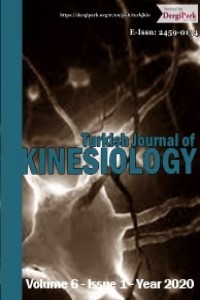Profile of soccer injuries at the 19th Nigerian University Games
Profile of soccer injuries at the 19th Nigerian University Games
Soccer, the most popular team sport in the world is associated with injuries. Profile of soccer injuries at the 19th Nigerian University Games was studied and the incidence, causes, locations, severity, mode of treatment and effect of play position on injuries were studied. The observational technique was used to obtain relevant data during the competition. Out of a total of 16 matches played and studied, 57 players were injured with 113 incidences of injuries recorded. The results were analyzed using frequency, percentages. The ankle was most frequently injured with 25 (22.12%) cases, while the groin and the foot regions were the least injured body part (1 case, 0.88%). The incidence of injury to the knee joint was 22 (19.47%). The most frequently injured body segment was the lower extremity, while the least injured body segment was the trunk. Minor injuries recorded were 48 (42.48%), while 2 (1.77%) serious injuries were observed. Most of the injuries sustained were due to direct trauma. Physiotherapy treatment included cryotherapy, massage and passive stretching of muscles. Midfielders recorded the highest number of injuries, while the highest number of injuries was recorded among the University of Ibadan soccer players. The Federal University of Technology, (FUTA) players sustained 5 (8.8%) the least injury. In conclusion, the most frequently injured segment of the body and body part was the lower extremity and the ankle respectively. Rules of the game should be modified to reduce the incidence of injuries in these body parts.
Keywords:
Injury NUGA games, soccer,
___
- Auley A, Gudmandsson A, Dahl HA, Johansson E. Soccer injuries in Ireland. Scand J Med Sci Sport, 1996; 6 (1): 40-45
- Cromwell F, Walsh J, Gormley J. A pilot study examining injuries in elite Gaelic footballers. Br J Sports Med, 2000; 34 (2): 104 -108.
- de Loes M, Dahlstedt LJ, Thomee R. A 7- year study on risks and costs of knee injuries in male and female youth participants in 12 sports. Scan J Med Sci Sport, 2000; 10 (2): 90-7
- Engstrom BK, Renstrom PA. How can injury be prevented in the world cup soccer athlete? Clinics Sports Med, 1998; 17 (4): 755-68
- Hartley A, Rotella J. Athletic therapy in sports medicine. In Handbook of Sports Medicine, Bull R.C (ed). Canada. McGraw Hill: 1999: 665
- Hawkins RD, Fuller CW. An examination of the frequency and severity of injuries and incidents at three levels of professional football. Br J Sport Med, 1998; 32 (4): 326-32.
- Hawkins RD, Hulse MA, Wilkinson C, Hodson A, Gibson M. The association football medical research programme: an audit of injuries in professional football. Br J Sport Med, 2001; 35 (1): 43-7.
- Khan AR, Khan MJ, Hawlader MDH. The epidemiological profile of knee injury pattern among different divisional football players. Turk J Kinesiol, 2019; 5(2): 50-56
- Lees A, Nolan L. The biomechanics of soccer injuries. A review. J Sport Sci, 1998; 16 (3): 211-34.
- Lower T. Sport injury patterns in urban and rural accident and emergency units. Aus J Rural Health, 1996; 4 (1): 28-32.
- Mahad A. Address by the Vice –Chancellor of Ahmadu Bello University, Zaria. NUGA 2002 Programme Book, Ibadan. Ibadan University Printery: 2002.
- McAuley D. Ankle injuries: Same joint, different sports. Med Sci Sport Exer, 1999; 31 (7 supp v): 3409-411.
- McGrath AC, Ozanne- Smith J. Heading injuries out of soccer. A review of the literature. Monash University Accident Research Centre-Report, 2000; No. 25:1
- McHardy A, Pollard H. Injury associated with soccer: A review of the epidemiology and etiology. J Sport Chir Rehab, 2001;15 (1): 34-43.
- Okuneye RO. The knowledge of sports injury and safety practices among age-grade soccer players. J Nig. Med Rehab Therapists, 1999; 4 (8): 23 –26.
- Olavi V, Nilsk, Kyosti L, Jukka P.K, Mats G, Pertti K. A prospective randomized double-blindedd trial of the efficacy of cold gel with soft tissue injuries. World Physical Therapy Book of Abstracts, 2003; RR-PL: 2288.
- Quinn K, Parker P, de Bie R, Rowe B, Handoll H. Interventions for preventing ankle ligament injuries. Cochrane Database System Rev, 2000; (2).
- Rahnama N, Reilly T, Lees A. Injury risks associated with playing actions during competitive soccer. Br J Sport Med, 2002; 36 (5): 354-9.
- Sanya AO, Owotade BO. Comparison of static balance performance in Nigerian amateur and professional footballers. J Nig. Med Rehab Therapist, 1998; 3 (5) 41-44.
- Schmidt-Olsen S, Jorgensen U, Kaalund S, Sorensen J. Injuries among young soccer players. Am. J Sport Med, 1991; 19: 273-275.
- Steinbruck K. Epidemilogy of sports injuries. 25-year analysis of sports orthopedic– traumatologic ambulatory care. Sportsveletz Sportschaden, 1999; 13 (2): 38-52.
- Soderman K, Adolphson J, Lorentzon B, Alfredson H. Injuries in adolescent female players in European football, a prospective study over one outdoor soccer season. Scand J Med Sci Sport, 2001; 11 (5): 299-304.
- Thomas, A., Skinner, A. & Piercy, J. Tidy’s Physiotherapy. 12th Edition. Butterworth-Heinemann Ltd. 1991
- Van- Mechelen W. Sports injury surveillance systems. One size fits all? Sport Med, 1997; 24. (3): 164-168.
- Yayın Aralığı: 4
- Başlangıç: 2015
- Yayıncı: Nurtekin Erkmen
